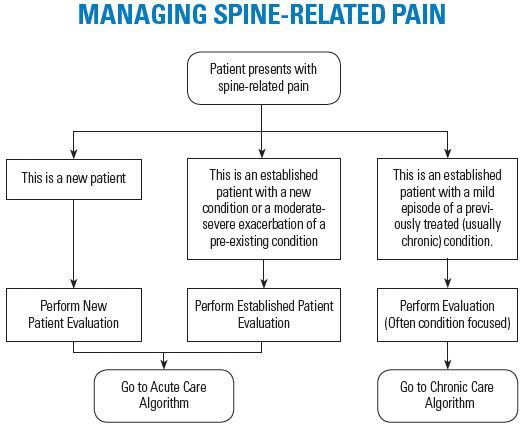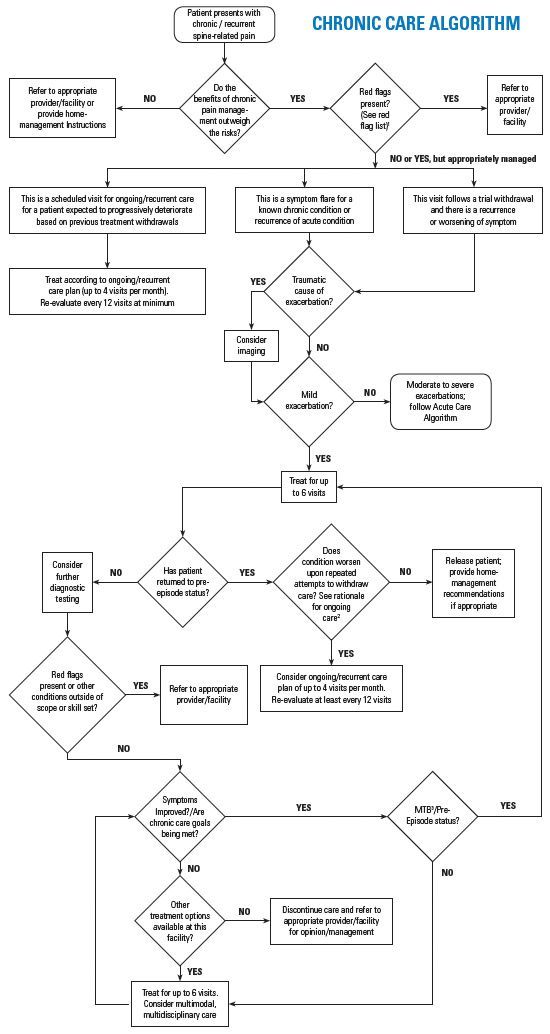For decades, injured athletes have spent countless hours aggressively stretching their Achilles tendons with the misguided belief that a more flexible calf is less prone to reinjury and more resilient when playing sports. Recent research shows that this is not the case; and it turns out there has been a significant amount of research showing the easiest way to tighten injured and/or aging tendons.
CCGPP Creates Clinical Algorithm to Help Manage Spine-Related Pain
It seems each managed care company or insurance company has its own idea as to what appropriate patient care looks like. Most of their protocols are developed internally; some without any reference to published literature and others influenced by outdated or incomplete literature. In addition, often the protocols that were designed for a specific patient population are used to manage other patient groups. For instance, it is very common for insurers to use uncomplicated acute care models even when dealing with chronic cases or cases with various complicating factors.
When each insurance company or managed care company has its own set of rules, it significantly complicates patient management, and may hinder overall patient outcomes and drive up costs. This is especially true when a large percentage of a doctor's patient population is unable to self-pay.
To address this issue, the Council on Chiropractic Guidelines and Practice Parameters (CCGPP) initiated several research projects. The results were subsequently published in JMPT starting in 2008. Those projects included "Chiropractic Management of Low Back Disorders: Report From a Consensus Process"; "Consensus Terminology for Stages of Care: Acute, Chronic, Recurrent, and Wellness"; and Management of Chronic Spine-Related Conditions: Consensus Recommendations of a Multidisciplinary Panel." These papers establish a foundation for defining an evidence-based model for treatment dosing for the care of spine-related pain.
In early 2012, the CCGPP decided to develop a new document that would bring the recommendations of the previous papers into a visual algorithm to help doctors, insurers and policy makers use the information more effectively. After much work, many iterations and a final critical review by a panel of experts, the document, "Algorithms for the Chiropractic Management of Acute and Chronic Spine-Related Pain," has been submitted to and published by Topics in Integrative Health Care. The CCGPP selected this journal because it is open access, meaning anyone can access the information within the journal for free at http://tihcij.com.
What follows are the visual algorithms presented in the paper. All of the above-referenced papers should be read in their entirety in order to fully understand the recommendations. Also, keep in mind that this algorithm is for spine-related pain only. It is not appropriate for other chiropractic objectives such as wellness care, subluxation care or structural care. Keep in mind that this is not a black-and-white prescription of care, as true evidence-based practice takes into consideration the evidence, patient values and clinician experience.
The essence of the algorithm is to ensure care is delivered according to patient need and response, not according to an arbitrary number of visits. Any visit-number suggestions are not to the point of release, but to the point of evaluation. If a patient continues to need care and the doctor documents that need and demonstrates the patient is favorably responding to care, then care can and should continue. If the patient is not responding to a trial of care, but the doctor has other treatment options that are likely to help, then the doctor can initiate a new trial of care.
Release, referral or transition to other non-spine-related care objectives should occur when the patient has reached maximum improvement or when the patient is not showing any improvement with the methods available by the doctor or facility.
The CCGPP hopes that this algorithm will help doctors provide rational, evidence-based care for their patients and also help reduce care denials for those following the recommendations within the document.



Article submitted by the Council on Chiropractic Guidelines and Practice Parameters. For more information about the CCGPP and its best-practices project, the Clinical Compass, visit www.clinicalcompass.org.


